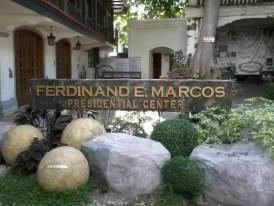 | ||
Address Batac, Ilocos Norte, Philippines Hours Open today · 9AM–12PM, 1–4:30PMSaturday9AM–12PM, 1–4:30PMSunday9AM–12PM, 1–4:30PMMonday9AM–12PM, 1–4:30PMTuesday9AM–12PM, 1–4:30PMWednesdayClosedThursday9AM–12PM, 1–4:30PMFriday9AM–12PM, 1–4:30PM Similar Malacañang of the North, Cape Bojeador Lighthouse, Paoay Church, Patapat Viaduct, Baluarte | ||
Ferdinand e marcos presidential center mausoleum batac ilocos norte tour by hourphilippines com
The Ferdinand E. Marcos Presidential Center is a museum situated in Batac, Ilocos Norte dedicated to former Philippine President Ferdinand Marcos which also hosts the cenotaph of the former President. The museum shows memorabilia of the late president, from his stint in the armed forces down to his presidency. The large cenotaph which contains the glass-encased coffin in which the widely believed embalmed body of Marcos was on public display shortly after his remains were brought in Ilocos Norte from the United States in 1993 until his body was re-interred at the Heroes' Cemetery in Taguig on November 18, 2016. A wax replica of Marcos remains to be displayed inside the glass coffin.
Contents
- Ferdinand e marcos presidential center mausoleum batac ilocos norte tour by hourphilippines com
- Ferdinand E Marcos death
- Return of Marcos remains
- The remains of Ferdinand Marcos
- References
Ferdinand E. Marcos' death
On September 28, 1989, Marcos died of lung, kidney and liver complications in Hawaii, three years after he, his family and allies were exiled. In 1986, Marcos fled the country in the face of a nonviolent revolution "people power" which set the end of his regime. The odyssey of his remains began when the government of President Corazon Aquino denied Marcos' return to the Philippines. Thus Marcos' remains was interred in a private air conditioned mausoleum at Byodo-In, a Japanese Buddhist temple, on the island of Oahu.
Return of Marcos' remains
In September 1993, after having been kept in a refrigerated, glass-topped coffin inside an air-conditioned crypt for four years, Marcos' remains were finally taken to the Philippines. The newly elected president who succeeded Aquino, Fidel Ramos, second cousin of the late president, allowed Imelda Marcos, Marcos' widow, to bring her husband's body home but refused her demand for a hero’s burial.
Eventually, after series of rituals and ceremonies, Marcos' remains were interred in a mausoleum in his hometown for public display, according to his family President Benigno Aquino III, son of the late Corazon and Benigno Aquino Jr., tasked Jejomar Binay to determine if Marcos should be buried in the Heroes' Cemetery. Binay made his recommendation, though Aquino has not yet made a decision. Just recently, the new president, Rodrigo Duterte approved Marcos burial in the cemetery and was buried in the place on November 18, 2016.
The remains of Ferdinand Marcos
Frank Malabed, Marcos' mortician, states that he has helped preserve the body during its interment at the former mausoleum in Barac. It took him three weeks to restore Marcos' body so that Filipinos would recognize it. Local morticians maintain and check it regularly. Formaldehyde was used to preserve the body before it was flown to the Philippines.
It was reported on August 2016, that Historian Antonio Montalvan II said that a close Marcos family friend of his revealed that the body displayed on the glass coffin was a wax figure and not the preserved remains of Ferdinand Marcos. Montalvan added that the real body of Marcos is buried underneath the glass coffin.
A wax replica of Marcos' remains was reportedly left inside the glass coffin on the day Marcos' real body was interred at the Heroes' Cemetery. There are reportedly two or three replicas of Marcos' body.
